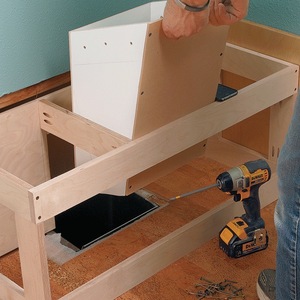I am about to start building a workshop.
One of my worries has been about building on a pad.
The top of the pad is just a few inches above grade.
This is a mono pour … I am use to having a frost wall.
I was going to use a pressure treated 2 x 6 … fasten it down with tapcons … then the 2 x 6 wall.
When I was looking from something to protect the bottom 12″ of the building (from hits from a lawn mower or weed eater, I came across Plastic Wood.
There are all kinds … the one I am looking at is made of “mineral-added high-density polyethylene plastic”
It has a 50 year guarantee … though I am always worried as these products have only been around for a few years.
Here is just one example: https://bearboardlumber.com/plastic-lumber-products/boards.html
They make a 2 x 6 for $3.75 per ft.
I am thinking about two of these all t he way round the outside before I start the siding.
The salesman suggested some people have used this as a sill plate.
I have a sample … looks pretty indestructible.
I am “guessing” it is better than pressure treat.
Question … good or bad idea?
Thanks …. Mike


















Replies
I see I missed a detail .... I should have said in the above post that I will put chemical anchors or wedge anchors in right through both sills after the walls are up. The tapcons are just to hold it in place till I get the wall up.
Thanks ....
I wouldn't use it as a sill plate; the website says it's not suitable for structural applications and shouldn't be used as a wood substitute in same. But I personally don't see any problem with using it as a "siding," (or really more like a parge coat?) the way you were originally thinking, although I'd imagine you could find something similar in an actual siding for less $. The website seems to imply it has insulative properties, too.
This stuff might be really useful for me in my work, btw, so thanks for the link!
That is how I was leaning. I was surprised when the salesman on the phone suggested using it as a sill.
I am not really worried about rotting ... just a bit if I pull a car in winter to work no it or have a coolant spill there could be water on the floor, but then the mud sill will be pressure treat ... I really like the idea of mechanical protection from say a weed eater or lawn mower.
Since this is thick and the same color all the way through, it it gets hit or marked up it really does not matter.
It is either this or something like cement board with a parge coat or maybe thin brick on it.
I also thought it might be good for say a garage door frame. It always takes a beating.
I have attached a picture of how I was thinking of using it. The pad is in (only about 3" of snow left on it .. can't wait to start). You can see I insulated the edged (and under it) ... then parged over the insulation.
Thanks ....
Ha, I'm not surprised the salesperson suggested it; they want to make a sale, they don't always care so much about the results. :-) (I mean, honestly, if the stuff is as strong and durable as they say it is, it would probably work fine as a sill plate, and probably the only reason the site says not to use it that way is they don't want to/haven't paid for the extensive testing it would require to be approved for that use, but of course caution is best with something like this--you don't want your building to collapse or need expensive repair because you/we assumed it would be okay.) Also, apparently petroleum products can damage it.
I don't see any problem using it the way you're suggesting, to protect the walls. It looks like pretty cool stuff. I build custom furniture/fancy dog crates/home decor, and I'm kind of itching to try some of it, though I think the pricing puts it out of the range of most of my clients (I pride myself on affordable quality--I don't have the money to spend $1200 on a crate for my dog, so I don't expect my clients to, either). But on those same lines, I still think you could probably find something less expensive to line the lower section of your walls; they make T&G decking out of a similar material, that's a bit cheaper but (afaik) just as durable. That said, if you think it might be subject to ding and weed-wacker hits, I don't know if cement board & parge coat is what you want, either, because it can chip, too.
A garage door frame (or trim, really) is a great idea, IMO.
What did you use to insulate under your pad, btw? I'm currently planning a couple of slabs, one of which will hold a sunroom (converting the back porch, using CMUs for the walls) and one of which will be walled in to form a covered walkway/storage room for my retired father, who lives with us in a converted cabin shell just off the back of the house--we're going to tie it in through the walkway, basically, and have storage between the new floor joists. So I was thinking of at least putting a radiant barrier under there, but possibly spray foam as well/instead; I guess you used foam boards? How thick?
I'd be itching to get started, too! I can't wait to hear how you progress!
Put a sill gasket under the sill to reduce moisture wicking up through the concrete. If the walls aren't finished inside, you can spray the sill with bora-care every 10 years. Cheap and easy and keeps the rot, carpenter ants, and termites away.
Not a contractor but I don't think I'm saying anything controversial.
Thanks ...
Yes, definitely a sill gasket.
In fact, I am even thinking one maybe between the two sills also.
I am doing some reading. The pad is not perfect and thus the gasket may not touch in all spots.
Someone a few years go when I had this problem at a different location suggested that I should have used a mastic (acoustic) caulk between the pad and the gasket to fill those little spots.
On the house I went nuts ... on the outside I crawled along the edge and put spray foam in every little gap (frost wall so the top was rough enough to leave gaps) and on the inside I crawled along the floor and calked the wall (sill) to the cement floor.
Probably over kill but I have 4800 sq ft and only pay $250 a month in natural gas to heat (and that is with a gas furnace, stove, hot water and dryer). Not bad for VT and a wife who likes the house at 72 all winter.
I plan on heating the shop to just above freezing (so coolant in machines, paint and my RV won't freeze) then heat the bay I am working in that day to a comfortable temperature (dividing the shop into three bays).
Thanks again !
A gasket between the two sills could trap moisture in the bottom sill plate and accelerate decay. If you are concerned about the integrity of the bottom gasket look into a EDPM sill gasket.
Hmmmm ... never thought of that!
I have never seen any gaskets except the foam ones (blue coil) ... I will look into that!.
Thanks ....